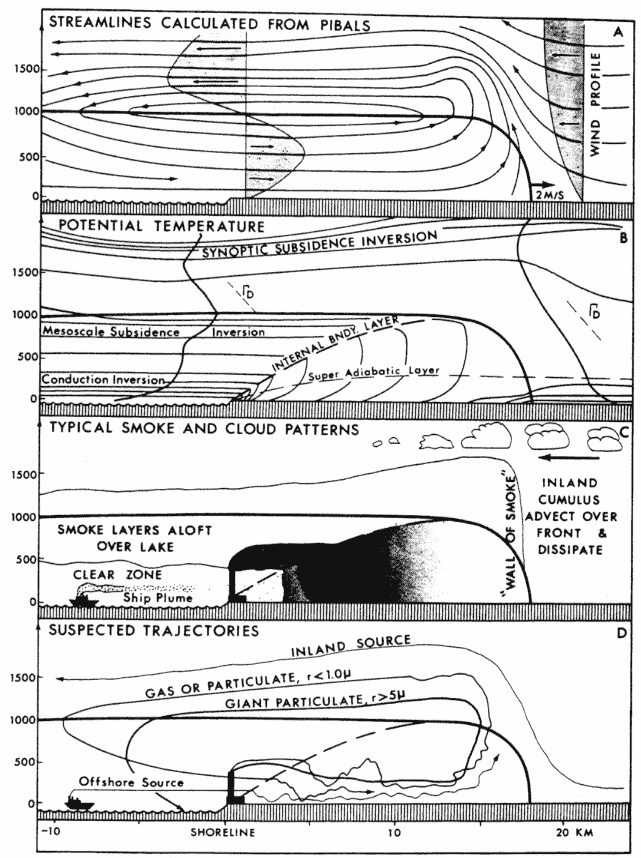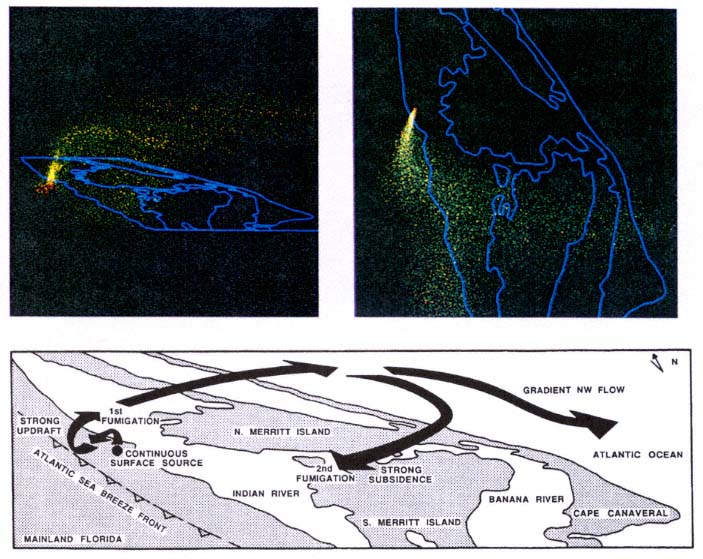7
Air Quality
A substantial fraction of the nation's and the world's populations, fossil and nuclear energy production, heavy industry, vehicular traffic, and energy exploration and production lie within 100 km of a coastline. The large emissions of primary, and the production of secondary, pollutants combined with complex and often adverse meteorological conditions can result in increased air pollution levels. An adequate understanding of coastal zone air pollution dispersion is required to license and control point sources of primary pollutants, design regional emission control strategies for secondary pollutants contributing to photochemical oxidants, develop and implement emergency responses to accidental releases of radiological and hazardous materials, assess dry and wet deposition of trace metals and other contaminants into sensitive coastal ecosystems, and, potentially, predict dispersion of militarily significant chemical and biological agents.
DISPERSION IN THE COASTAL ZONE
Substantial progress has been made in understanding the mechanisms involved with dispersion over distances ranging from tens of meters to circumglobal. However, a gap appears in our understanding of processes involved in mesoscale dispersion (10 to 100 km), particularly when mountainous and coastal regions are involved.
Coastal zone dispersion issues have been summarized by Lyons (1975), Lyons et al. (1983), Pielke (1984), and Zanetti (1990). Dispersion is the combined impact of diffusion and transport. Both are influenced by the
intense gradients of surface fluxes, roughness, turbulence, insolation, mixing depths, and horizontal and vertical winds of the coastal zone. Modification of stable onshore flowing air over heated land results in sharp discontinuities in diffusive behavior, including continuous fumigation of elevated plumes (Lyons and Cole, 1976). A comparison of different coastal fumigation models is given by Stunder and Raman (1986). Plume trapping over land and ribbon plumes over water can result in locally high pollutant concentrations (Lyons et al., 1983). The diurnal cycling from land breeze to sea breeze presents special problems, especially for emergency response planners. Tracers, tetroons, sulfate aerosol data, and aerometric studies in the Los Angeles basin, the Chicago-Milwaukee area, along the U.S. east coast, and elsewhere suggest that materials transported offshore in a land breeze can advect back onshore in relatively high concentrations during the subsequent sea breeze and often at undetermined locations (Shearer and Kaleel, 1982).
Figure 7.1 summarizes many known coastal zone dispersion features and, rather like much of our understanding of these issues, is biased toward the two-dimensional and steady state. Yet plume transport in coastal zones involves inherently three-dimensional dynamic processes. Lyons and Cole (1976) hypothesized that mesoscale transport in sea breezes took the form of broad quasi-helical vortices extending parallel to the shore. Very finemesh mesoscale numerical dispersion modeling of complex wind fields at the Kennedy Space Center (Lyons et al., 1991a) demonstrated that even a dense two-dimensional surface layer wind network cannot consistently describe plume behavior. During sea breezes, plumes from continuous sources can evolve into contorted patterns.
As illustrated in Figure 7.2, pollutants moving inland and perhaps undergoing fumigation can thereafter be vertically translocated many hundreds of meters aloft in the strong updrafts associated with wind field discontinuities. Subsequently, these plumes can divide into several branches, with some material entering the gradient wind layer aloft and exiting the region. The remainder subsides into the sea breeze inflow layer, perhaps undergoing fumigation to the surface again many tens of kilometers from the source. These processes can become even more complicated in the presence of heated coastal mountain slopes.
Coastal katabatic winds are important locally since they result in the ventilation and consequent abatement of nocturnal pollutants in cities located on slopes (Ulrickson and Mass, 1990a, b). The size sorting of aerosols and pollen in regions of strong land and sea breeze systems' ascent and descent (Lyons, 1975; Lyons et al., 1991b) shows that shear-induced diffusion and dry deposition processes over water still require much additional study. The influence of coastal mesoscale systems on optical and other electromagnetic transmissions is not completely understood.

Figure 7.1 Structure of a typical lake or sea breeze circulation along a straight shoreline with flat terrain. Illustrated are recirculating flows, limited mixing depths in coastal zones, dynamic fumigation associated with the thermal internal boundary layer, and size sorting of aerosols. This two-dimensional conceptual model has been extant since the mid-1970s (Lyons, 1975). Current efforts require verifying and quantifying many aspects of this model and expanding it to include the threedimensional structure of the land-sea breeze and its impacts on mesosale transport and clouds in regions of irregular coastlines, islands, estuaries, and complex topography.

Figure 7.2 (top) Dispersion model simulation of plume transport in the complex coastal wind fields of the Kennedy Space Center. Plan view (left) of the predicted plume of particles released from a continuous surface source over the Indian River, and (right) the same plume seen from an elevated southwesterly perspective showing the three-dimensional nature of the transport processes. (bottom) Schematic showing that pollutants initially move inland in the Atlantic sea breeze inflow. They then rise rapidly in the strong updrafts in the sea breeze front over the Florida mainland. Some of the pollution subsides back into the sea breeze inflow due to strong subsidence over the Indian River and then fumigates again as it moves inland some 20 km south of the source. The other branch of the plume, ejected higher into the gradient flow, drifts almost due east as it exits the region (Lyons et al., 1991a). Graphics courtesy of Cecil S. Keen.
The mechanisms by which vertical and horizontal recirculation processes degrade coastal air quality are only partially understood. Pollutant reen-trainment back into the inflow from the elevated return flow layer in offshore subsidence zones remains unquantified. Coastal circulations are major factors in exacerbating regional photochemical ozone pollution. Violations of the U.S. federal standard for ozone are four times more likely within 20 km of the Lake Michigan shoreline than inland (Lyons et al., 1991b). Worldwide ozone levels in cities as diverse as Oslo, Toronto, Athens, and Tokyo are strongly influenced by local sea breeze circulations and interactions with urban and complex terrain-induced circulations. Low-level jets in lake breeze cells over the Great Lakes have not been well documented but may play a crucial role in regional photochemical pollution transport. Developing improved conceptual and mathematical models of the myriad processes involved is an ongoing challenge.
DEVELOPING IMPROVED DISPERSION MODELS
The majority of diffusion simulation codes used today utilize the straight-line Gaussian plume (or its progeny), segmented plume, or puff models. This results largely from these models' relatively modest computational requirements, easily available input data, conceptual simplicity, and widespread acceptance by regulatory agencies. While they achieve modest accuracy in idealized environments, the gradients of heat flux, mixing depth, and surface roughness, as well as intense shear, updrafts, and subsidence, severely limit their suitability in coastal zones. During the past decade, mesoscale numerical models (MNMs) have gradually emerged as the basis of more advanced dispersion systems. The National Center for Atmospheric Research/Penn State MM4 model has successfully provided input to the Regional Acid Deposition Model (RADM). By the late 1980s, three-dimensional prognostic codes began to drive regional photochemical grid models, especially in California (Tesche, 1991).
The emergence of affordable high-speed computing portends increasingly widespread use of numerical codes in dispersion research. Many empirical models of the thermal internal boundary layer (TIBL) have been developed for coastal fumigation calculations (Venkatram, 1986). Stunder and Raman (1985) have tested and compared various TIBL formulations. Most do not address such factors as wind shear, variable initial air mass lapse rate, or coastal zone vertical motion. A high-resolution two-dimensional MNM provides a more generalized treatment of the TIBL. Three-dimensional MNMs account for such factors as heterogeneous land surfaces, complex topography, and irregular coastline shapes. By predicting the atmospheric state variables at each model grid point and time step, the MNM serves as the basis for new dispersion calculation methodologies.
New MNM-driven Lagrangian particle models, hybrid Lagrangian-Eulerian dispersion schemes, and source/receptor quantification methods show promise for the regulatory, operational, and research arenas (Uliasz and Pielke, 1990).
Considerable effort remains before new dispersion methodologies become generally applicable tools. Four-dimensional data assimilation techniques, successfully used in regional MNMs, must be adapted to the strong gradients of the coastal zone (Stauffer et al., 1990). The required intensive model evaluation studies will benefit from (1) improvements in technologies capable of resolving mesosale vertical motion fields with a minimum detectable signal on the order of 10 cm/sec; (2) surface and airborne remote sensing systems that can map specific pollutant species (such as ozone); (3) improved sampling systems, including real-time airborne monitors, for longer-range (~100 km) tracers, such as perfluorocarbons for model evaluation and source attribution studies; and (4) a tracer that can be mapped using a volumetric remote sensing system over a relatively wide region. The interactions of coastal circulations with primary and photochemical aerosols and their treatment in regional meteorological and photochemical models are largely unaddressed issues in ozone and visibility modeling.
Few field programs have been designed to observe coastal circulations and mesoscale dispersion on both sides of the littoral with equal intensity and through their entire diurnal cycle. There is a dearth of comprehensive studies of dispersion in the land breeze. Improved coordination of large-scale air quality research efforts (which concentrate efforts over land) with offshore air-sea interaction studies would benefit both groups of investigators.
SUMMARY AND CONCLUSIONS
Transport and diffusion processes in coastal zones are only partially understood, and what knowledge there is, is weighted toward straight coastlines in flat terrain under idealized meteorological conditions. Dispersion modeling techniques currently in widespread use do not always account for even the known coastal zone dispersion mechanisms. Continued advances in affordable high-speed computing, prognostic mesoscale numerical modeling, and advanced dispersion simulation techniques promise to yield a more comprehensive understanding of coastal zone phenomena. Furthermore, these advanced technologies, once adequately tested, will soon be able to replace many current dispersion modeling systems used by the regulatory and emergency response communities.
The panel recommends the following:
-
There should be continued development and testing of advanced prognostic meteorological and coupled dispersion models to simulate, and eventually
-
operationally forecast, the impacts on pollutants of organized mesoscale vertical motions and intense horizontal and vertical gradients of wind, temperature, and turbulence found in three-dimensional, time-dependent coastal mesoscale regimes.
-
Further investigations should be made of the role of coastal circulations in aggravating regional photochemical oxidant episodes, including interactions between locally emitted pollutants and those entering the region through long-range transport.
-
Comprehensive tracer programs should be conducted at increasingly less idealized coastal sites, which would allow for evaluation, validation, and eventual widespread use of improved dispersion models, as well as further quantification of the complex transport and diffusion processes affecting pollutants in the coastal zone.
-
Improved coordination should be required between air pollution and boundary layer field observation programs conducted on both sides of the littoral, which would advance knowledge of the underlying physical processes affecting dispersion over land, water, and the intervening transition zones.








